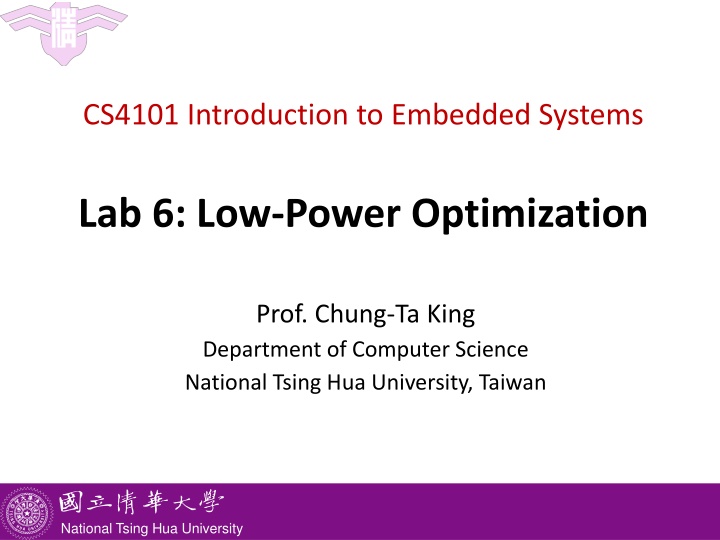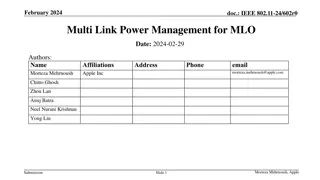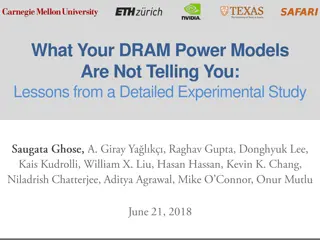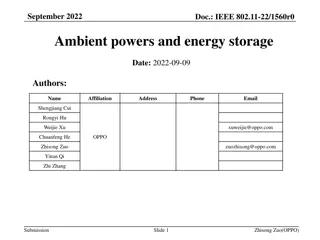
Low-Power Optimization for MSP430 LaunchPad - Lab 6 Overview
Explore low-power optimization techniques for MSP430 LaunchPad in Lab 6 at National Tsing Hua University. Understand the MSP430 low-power modes, controlling mechanisms, and sample code for ADC10. Dive into power-efficient practices with Prof. Chung-Ta King in this informative session.
Download Presentation

Please find below an Image/Link to download the presentation.
The content on the website is provided AS IS for your information and personal use only. It may not be sold, licensed, or shared on other websites without obtaining consent from the author. If you encounter any issues during the download, it is possible that the publisher has removed the file from their server.
You are allowed to download the files provided on this website for personal or commercial use, subject to the condition that they are used lawfully. All files are the property of their respective owners.
The content on the website is provided AS IS for your information and personal use only. It may not be sold, licensed, or shared on other websites without obtaining consent from the author.
E N D
Presentation Transcript
CS4101 Introduction to Embedded Systems Lab 6: Low-Power Optimization Prof. Chung-Ta King Department of Computer Science National Tsing Hua University, Taiwan National Tsing Hua University
Introduction In this lab, we will learn power optimization of MSP430 LanuchPad Configuring the low-power modes of MSP430 1 National Tsing Hua University
MSP430 Low-Power Modes Mode Active LPM0 LPM1 LPM2 LPM3 LPM4 CPU and Clocks CPU active; all enabled clocks active CPU, MCLK disabled; SMCLK, ACLK active CPU, MCLK disabled; DCO disabled if not for SMCLK; ACLK active CPU, MCLK, SMCLK, DCO disabled; ACLK active CPU, MCLK, SMCLK, DCO disabled; ACLK active CPU and all clocks disabled 2 National Tsing Hua University
Controlling Low Power Modes Through four bits in Status Register (SR) in CPU SCG0 (System clock generator 0): when set, turns off DCO, if DCOCLK is not used for MCLK or SMCLK SCG1 (System clock generator 1): when set, turns off the SMCLK OSCOFF (Oscillator off): when set, turns off LFXT1 crystal oscillator, when LFXT1CLK is not use for MCLK or SMCLK CPUOFF (CPU off): when set, turns off the CPU All are clear in active mode 3 National Tsing Hua University
Controlling Low Power Modes Status bits and low-power modes 4 National Tsing Hua University
Sample Code 1 for ADC10 Repetitive single conversion: A single sample is made on A1 with reference to Vcc If A1 > 0.5*Vcc, P1.0 set, else reset. Software sets ADC10SC to start sample and conversion. ADC10SC automatically cleared at end of conversion. Use ADC10 internal oscillator to time the sample and conversion. 5 National Tsing Hua University
Sample Code 1 for ADC10 #include "msp430.h" void main(void) { WDTCTL = WDTPW + WDTHOLD; // Stop WDT // H&S time 16x, interrupt enabled ADC10CTL0 = ADC10SHT_2 + ADC10ON + ADC10IE; ADC10CTL1 = INCH_1; // Input A1 ADC10AE0 |= 0x02; // Enable pin A1 for analog in P1DIR |= 0x01; // Set P1.0 to output for (;;) { ADC10CTL0 |= ENC + ADC10SC; // Start sampling __bis_SR_register(CPUOFF + GIE); // Sleep if (ADC10MEM < 0x1FF) // 0x1FF = 511 P1OUT &= ~0x01; // Clear P1.0 LED off else P1OUT |= 0x01; // Set P1.0 LED on } } 6 National Tsing Hua University
Sample Code 1 for ADC10 // ADC10 interrupt service routine #pragma vector=ADC10_VECTOR __interrupt void ADC10_ISR(void) { __bic_SR_register_on_exit(CPUOFF); // Clear CPUOFF bit from 0(SR) } 7 National Tsing Hua University
Sample Code 2 for ADC10 Continuous sampling driven by Timer0_A A1 is sampled 16/second (ACLK/2048) with reference to 1.5V, where ACLK runs at 32 KHz driven by an external crystal. If A1 > 0.5Vcc, P1.0 is set, else reset. Timer0_A is run in up mode and its CCR1 is used to automatically trigger ADC10 conversion, while CCR0 defines the sampling period. Use internal oscillator times sample (16x) and conversion (13x). 8 National Tsing Hua University
Sample Code 2 for ADC10 #include "msp430.h" void main(void) { WDTCTL = WDTPW + WDTHOLD; // Stop WDT // TA1 trigger sample start ADC10CTL1 = SHS_1 + CONSEQ_2 + INCH_1; ADC10CTL0 = SREF_1 + ADC10SHT_2 + REFON + ADC10ON + ADC10IE; __enable_interrupt(); // Enable interrupts. TA0CCR0 = 30; // Delay for Volt Ref to settle TA0CCTL0 |= CCIE; // Compare-mode interrupt. TA0CTL = TASSEL_2 + MC_1; // SMCLK, Up mode. LPM0; // Wait for settle. TA0CCTL0 &= ~CCIE; // Disable timer Interrupt __disable_interrupt(); 9 National Tsing Hua University
Sample Code 2 for ADC10 ADC10CTL0 |= ENC; // ADC10 Enable ADC10AE0 |= 0x02; // P1.1 ADC10 option select P1DIR |= 0x01; // Set P1.0 output TA0CCR0 = 2048-1; // Sampling period TA0CCTL1 = OUTMOD_3; // TACCR1 set/reset TA0CCR1 = 2046; // TACCR1 OUT1 on time TA0CTL = TASSEL_1 + MC_1; // ACLK, up mode // Enter LPM3 w/ interrupts __bis_SR_register(LPM3_bits + GIE); } Timer_A CCR1 out mode 3: The output (OUT1) is set when the timer counts to the TACCR1 value. It is reset when the timer counts to the TACCR0 value. 10 National Tsing Hua University
Sample Code 2 for ADC10 // ADC10 interrupt service routine #pragma vector=ADC10_VECTOR __interrupt void ADC10_ISR(void){ if (ADC10MEM < 0x1FF) // ADC10MEM = A1 > 0.5V? P1OUT &= ~0x01; // Clear P1.0 LED off else P1OUT |= 0x01; // Set P1.0 LED on } #pragma vector=TIMERA0_VECTOR __interrupt void ta0_isr(void){ TA0CTL = 0; LPM0_EXIT; // Exit LPM0 on return } 11 National Tsing Hua University
Lab 6 Basic 1: Flash the green LED at 1 Hz in LPM3 using Timer0_A and measure the temperature using ADC10 at 1 Hz driven by Timer0_A. Calculate the average temperature of last 2 sec. If the average temperature is higher than 30oC, enter LPM0, measure temperature and flash the red LED at 2 Hz, and calculate the average temperature of the past 2 sec. If the average temperature is higher than 35oC, enter active mode, measure temperature and flash both LEDs at 5 Hz, and calculate the average temperature of last 2 sec. 12 National Tsing Hua University
Lab 6 Basic 1: (cont d) Go back to the initial state when the average temperature drops below 30oC. Draw a finite-state machine to show the logic of your code. Try to minimize the time spent in the ISR. 13 National Tsing Hua University
Lab 6 Bonus: (Game of Memory) Put LaunchPad to LPM4 and wait for button input to start the game. Once the button is pressed, enter LPM0 and turn on the red LED for a random period. After the red LED is turned off, immediately press the button for the duration that the red LED is on. Calculate the difference between the on-time of the red LED and the button. If the difference is larger than 0.5 second, then you lose. Flash the green LED at 2 Hz for 3 seconds and return to the waiting state. 14 National Tsing Hua University
Lab 6 Bonus: (cont d) At the nth round, turn on the red LED for a random period for n times, with a random interval between two on-time. Ignore button activities during this period of time. After the nth on-time, immediately press the button for the duration of the sum of the n on-time. Calculate the difference between the on-time of the red LED and the button. If the difference is larger than 0.5 second, then you lose. Flash the green LED at 2 Hz for 3 seconds and return to the waiting state. Otherwise, you can enter the next round. 15 National Tsing Hua University






















